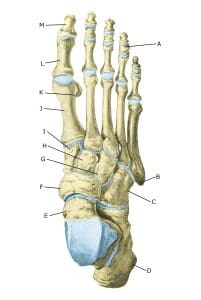Anatomy
The bones of the foot include 7 tarsal bones (ossa tarsi), 5 metatarsal bones (ossa metatarsi) and the bones of the toes (phalanx). In addition, the lower part of the shinbone (tibia) and fibula (fibula) are part of the foot joint.

The foot, from the top:
A. Phalanx media
B. Tuberositas ossis metatarsalis V
C. Os cuboideum
D. Calcaneus
E. Talus
F. Os naviculare
G. Os cuneiforme laterale
H. Os cuneiforme intermedium
I. Os cuneiforme mediale
J. Os metatarsalei
K. Os sesamoideum
L. Phalanx proximalis
M. Phalanx distalis
Cause
A single violent impact, such as a blow or twist, can cause a bone fracture. In adolescents, a proportion of ankle fractures occur in the growth zone (epiphysis). Many repetitive strains can result in fatigue fractures (stress fracture). In many cases of sudden overload, a bone tear occurs.
Symptoms
Pain on pressure (direct and indirect tenderness) and strain (walking, running).
Examination
X-ray examination will usually show the fracture. In some cases, the fracture can only be seen after 14 days, which is why a repeat X-ray may be necessary if a fracture is still suspected.
Bone fractures can often be seen faster on ultrasound and MRI scans, Ultrasound scans are increasingly being used to investigate suspected fractures in children as the examination is quick, painless, risk-free and inexpensive (Iacob R, et al. 2022).
Treatment
Treatment depends entirely on which bones are broken and whether there is displacement of the fracture surfaces. In mild cases with no displacement of the fracture surfaces, partial weight bearing without bandaging may be sufficient, while other fractures require bandaging and in the case of displacement of the fracture surfaces often surgery (especially in the ankle) (Marson BA, et al. 2019).
Rehabilitation, specific:
The load and rehabilitation that can be allowed is entirely dependent on the severity and treatment of the fracture, which is why all rehabilitation should be carried out in close co-operation with the doctors supervising the treatment. Of course, it’s important to keep all other muscles and joints working (see Rehabilitation, general).
Complications
If it doesn’t progress smoothly, you should be re-evaluated by your doctor to ensure that the fracture is healing as planned. In some cases, a false joint (pseudoarthrosis) may form, which will require (re)surgical treatment. If the fracture involves the growth zones of the tibia at the ankle, there is a risk of growth disturbances.
